Understanding Body Refrigeration Timeframes
When families face the loss of a loved one, one of their first questions is often about timing. How long can a body be refrigerated before burial isn't just a practical concern—it's a question that touches on our need to honor the deceased while navigating our own grief journey.
The answer depends on several factors, with temperature control and state regulations being the most crucial:
| Refrigeration Duration | Conditions | Notes |
|---|---|---|
| 3-4 weeks | At 35°F-40°F (2°C-4°C) | Optimal preservation window |
| 24-48 hours | Legal requirement in many states | Minimum time before preservation required |
| Up to 21 days | Hospital mortuary standard | Varies by facility |
| 8 days | Maximum in some states (e.g., North Dakota) | Some states prohibit extended refrigeration |
In the delicate days following a death, funeral directors become partners in balancing emotional needs with practical considerations. Modern refrigeration at 35°F to 40°F creates a gift of time by significantly slowing the natural decomposition process. This cooling inhibits bacterial growth, allowing families to gather, travel, and make thoughtful arrangements without feeling rushed through their grief.
I've spent over 15 years helping funeral homes steer these sensitive timeframes through designing custom refrigeration solutions. What I've learned is that while refrigeration provides precious time, it isn't indefinite. Even under ideal conditions with perfect temperature control, changes to the body become increasingly noticeable after that 3-4 week window, often requiring additional considerations for viewing or services.
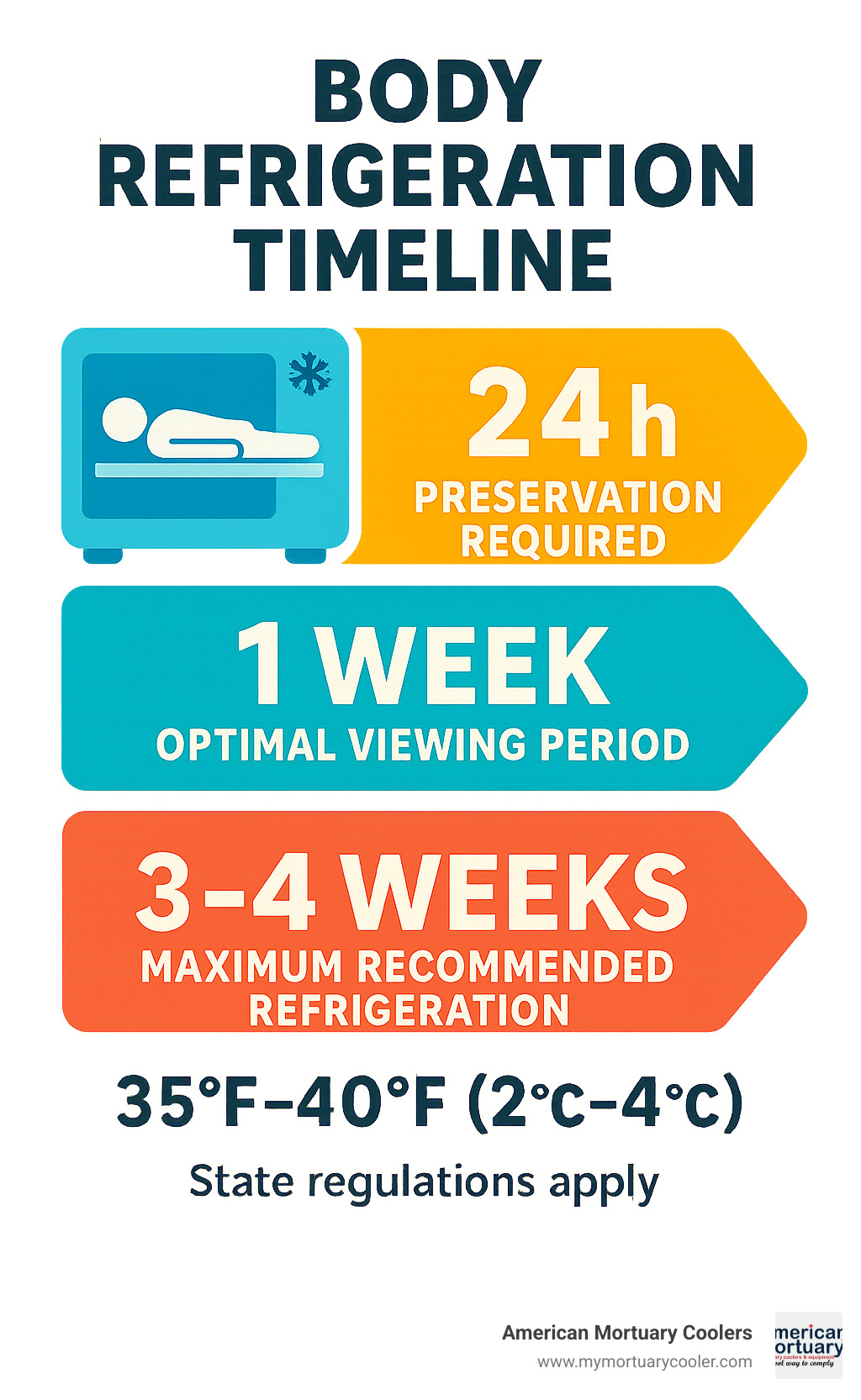
The timeline above illustrates what many funeral professionals consider the sweet spot for refrigeration. That first week typically offers the best conditions for viewing, while the full 3-4 weeks provides families maximum flexibility for making arrangements. Throughout this period, proper temperature control remains the single most critical factor in maintaining dignity for the deceased.
For those looking to understand more about the technical aspects of body preservation, these resources provide additional context:
- Morgue freezer temperature 101: how cold is a morgue freezer
- Detailed guide to mortuary chamber: purpose and function
- Everything you need to know about funeral home body freezers
At American Mortuary Coolers, we understand that behind every technical question about how long can a body be refrigerated before burial is a family seeking to honor their loved one with dignity and care. Our refrigeration solutions are designed with both the practical requirements and the emotional needs of families in mind.
The Science & Variables Behind Body Refrigeration
When someone passes away, nature doesn't pause - it immediately sets biological processes in motion. Understanding these natural changes helps explain why proper refrigeration is so crucial for maintaining dignity and creating time for meaningful goodbyes.
The Decomposition Process
The human body is home to trillions of bacteria that continue living after we die. Without the immune system keeping them in check, these microorganisms begin breaking down tissues, starting in the intestines and spreading outward. At room temperature, visible changes can appear within just 24-72 hours.
"Nature has already begun her process by the time some families decide on funeral arrangements," notes Lee Webster, a home funeral advocate. "Early cooling is critical for better outcomes."
Rigor mortis - that temporary stiffening of muscles we often associate with death - typically begins within 2-6 hours and may last up to 48 hours before gradually subsiding. This is just one of many natural processes that proper refrigeration helps manage by essentially pressing the "slow motion" button on these biological changes.
Temperature: The Critical Factor
When it comes to how long can a body be refrigerated before burial, temperature control isn't just important - it's everything:
35°F to 40°F (2°C to 4°C) is the sweet spot for preservation. This range is cool enough to significantly slow bacterial activity without causing the tissue damage that freezing would create. Think of it as the "Goldilocks zone" - not too warm, not too cold.
"Keeping the body at a consistent temperature below 40°F sufficiently delays decomposition without chemicals," according to industry experts at Everplans.
Drift below 35°F, and you risk cellular damage from ice crystal formation. Allow the temperature to creep above 40°F, and bacterial activity accelerates, potentially shortening the viable preservation window.
Mortuary Cooler Technology
Modern mortuary coolers aren't just refrigerators - they're specialized environments designed with precision and respect in mind.

Today's professional-grade coolers feature thoughtful details that make a difference: vapor-proof LED lighting for gentle illumination, digital temperature displays for constant monitoring, high-density insulated panels (typically 4 inches thick) for temperature stability, and magnetic door gaskets ensuring airtight seals. Most feature stainless steel interiors that not only support proper sanitation but also withstand years of dedicated service.
At American Mortuary Coolers, we've learned through years of experience that proper air circulation within the cooler is just as important as the temperature setting itself. Our units are designed with optimal airflow patterns that eliminate warm spots and ensure consistent cooling throughout the chamber.
Humidity control also plays a vital role in preservation quality. Too dry, and tissues can dehydrate prematurely; too humid, and it can accelerate certain decomposition processes. The best systems maintain humidity levels that complement the cooling process.
More info about cooler standards
Scientific research on the decomposition process
Understanding these scientific principles helps explain why proper refrigeration can extend the time families have to gather, grieve, and say goodbye - while still ensuring dignity and respect for their loved one throughout the process.
How Long Can a Body Be Refrigerated Before Burial?
When families ask how long can a body be refrigerated before burial, they're often seeking clarity during an already difficult time. It's a practical question that comes up when making funeral arrangements, and the answer balances scientific reality with legal requirements and family needs.
The 3-4 Week Guideline: Fact or Myth?
In my years working with funeral homes across the country, I've found that properly refrigerated remains (at 35°F to 40°F) can generally be preserved for three to four weeks before burial or cremation. This isn't just an arbitrary timeframe – it reflects the point where changes become noticeable even with excellent refrigeration.
"A refrigerated body will typically last three to four weeks at two degrees Celsius," confirms what we've observed with our clients nationwide. However, this guideline assumes ideal conditions: continuous refrigeration, proper temperature control, prompt cooling after death, and no unusual factors that might speed decomposition.
Real-world circumstances can affect this timeline. For instance, hospital morgues typically have policies limiting storage to 21 days. This reflects both their space limitations and the practical realities of refrigeration effectiveness.
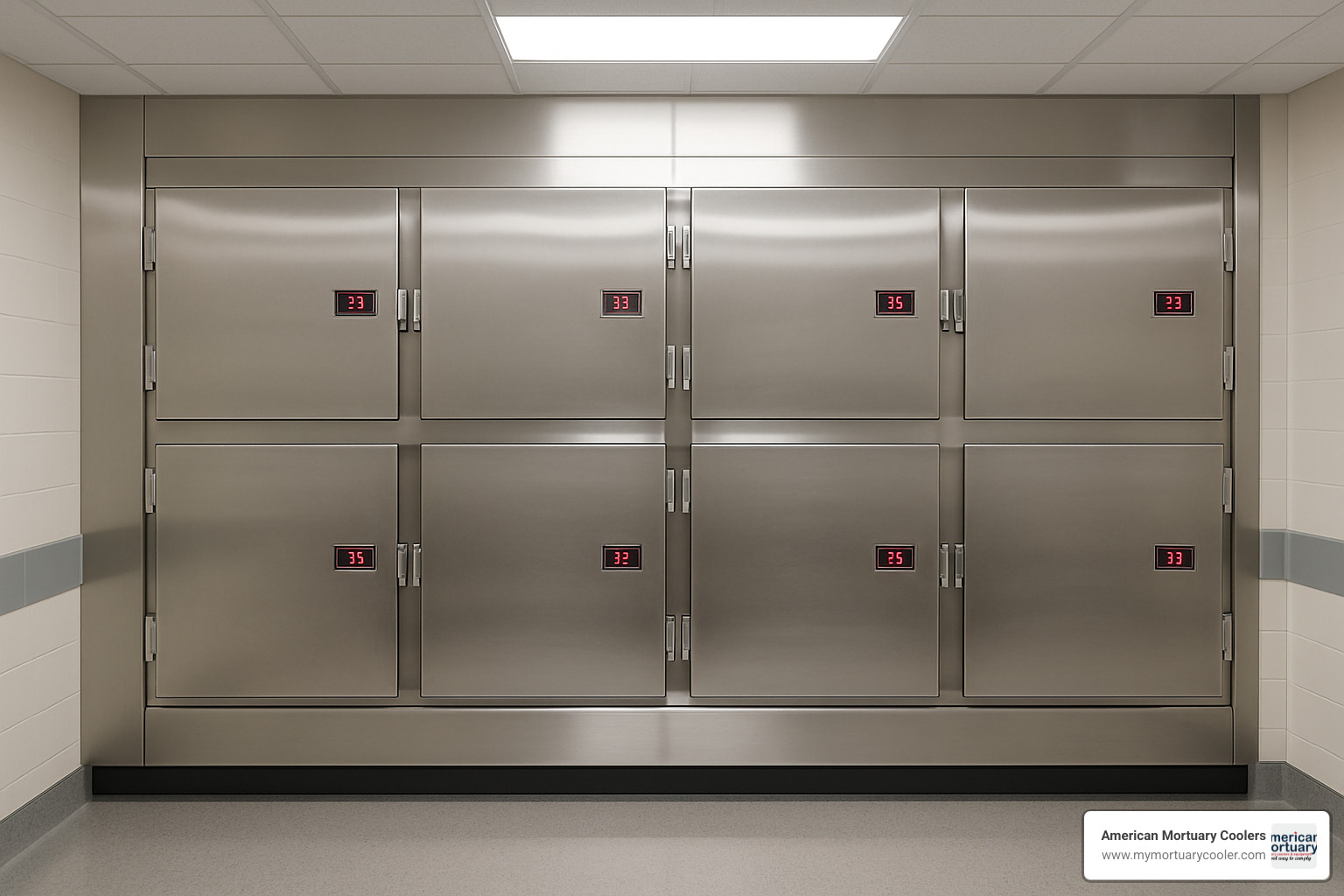
Several factors might shorten or extend this window. Bodies that have undergone autopsy often have shorter viable refrigeration periods due to additional exposure to air and bacteria. International transport creates special challenges, often requiring both refrigeration and embalming, along with extensive documentation. And religious traditions that require burial within 24 hours make refrigeration just a very short-term solution.
I've worked with funeral homes serving diverse communities, and the refrigeration needs vary tremendously based on these cultural and practical factors.
More info about refrigeration duration
State Laws & Legal Deadlines for Refrigerated Remains
The legal landscape adds another layer to understanding how long can a body be refrigerated before burial. These regulations aren't uniform across the country:
Many states like Pennsylvania and New Jersey have 24-48 hour rules requiring that a body be embalmed, refrigerated, or buried within 24-48 hours of death. This doesn't limit how long refrigeration can continue, but mandates when preservation must begin.
Some states create administrative checkpoints. In Oregon, for example, funeral homes must report if they're holding a body for more than 10 days.
North Dakota stands out with an explicit 8-day maximum disposal requirement and specific restrictions on refrigeration in certain cases – one of the stricter approaches nationwide.
Other states take a more flexible approach with "reasonable time" standards. Connecticut and Indiana use this language, essentially trusting funeral professionals' judgment based on conditions and circumstances.
A Florida funeral director explained their state's typical approach to me: "A body must be embalmed, refrigerated, or buried within 24 hours of death unless embalmed." This establishes when refrigeration must start, not when it must end.
By contrast, Australia spells things out more clearly: non-funeral directors may keep a body up to 5 days, while hospitals can store bodies for up to 21 days. Extensions require formal approval based on the condition of the body and storage facilities.
What Happens If Refrigeration Goes Too Long?
Despite best practices, sometimes bodies remain refrigerated beyond recommended periods. The consequences can affect everyone involved:
Even with excellent refrigeration, bodies eventually show signs of deterioration. Skin discoloration becomes more prominent, tissue breakdown progresses, and fluid leakage can occur. These changes often lead to situations where an open-casket viewing becomes inadvisable, limiting families' options for saying goodbye.
The legal and emotional consequences can be serious. A case reported by the New York Times illustrated this painfully: a lawsuit filed after a cruise ship passenger died alleged that his body "horrifically decomposed" after being stored in a drink cooler at insufficient temperature for nearly a week because the ship's morgue wasn't functioning properly. The family was unable to have the open-casket funeral they wanted.
This heart-wrenching situation highlights both the emotional impact on grieving families and the potential legal liability when refrigeration standards aren't maintained.
New York Times negligence report
At American Mortuary Coolers, we've helped many funeral homes upgrade their refrigeration systems after experiencing preservation failures. These situations damage their reputation and, more importantly, cause additional distress to families during an already difficult time. Proper refrigeration isn't just about following regulations—it's about honoring the deceased and supporting those who are grieving.
Preservation Options Compared: Refrigeration, Embalming & More
When considering how long can a body be refrigerated before burial, it's helpful to understand how refrigeration stacks up against other preservation methods. Each approach comes with its own timeline, benefits, and considerations for families making difficult decisions during a sensitive time.
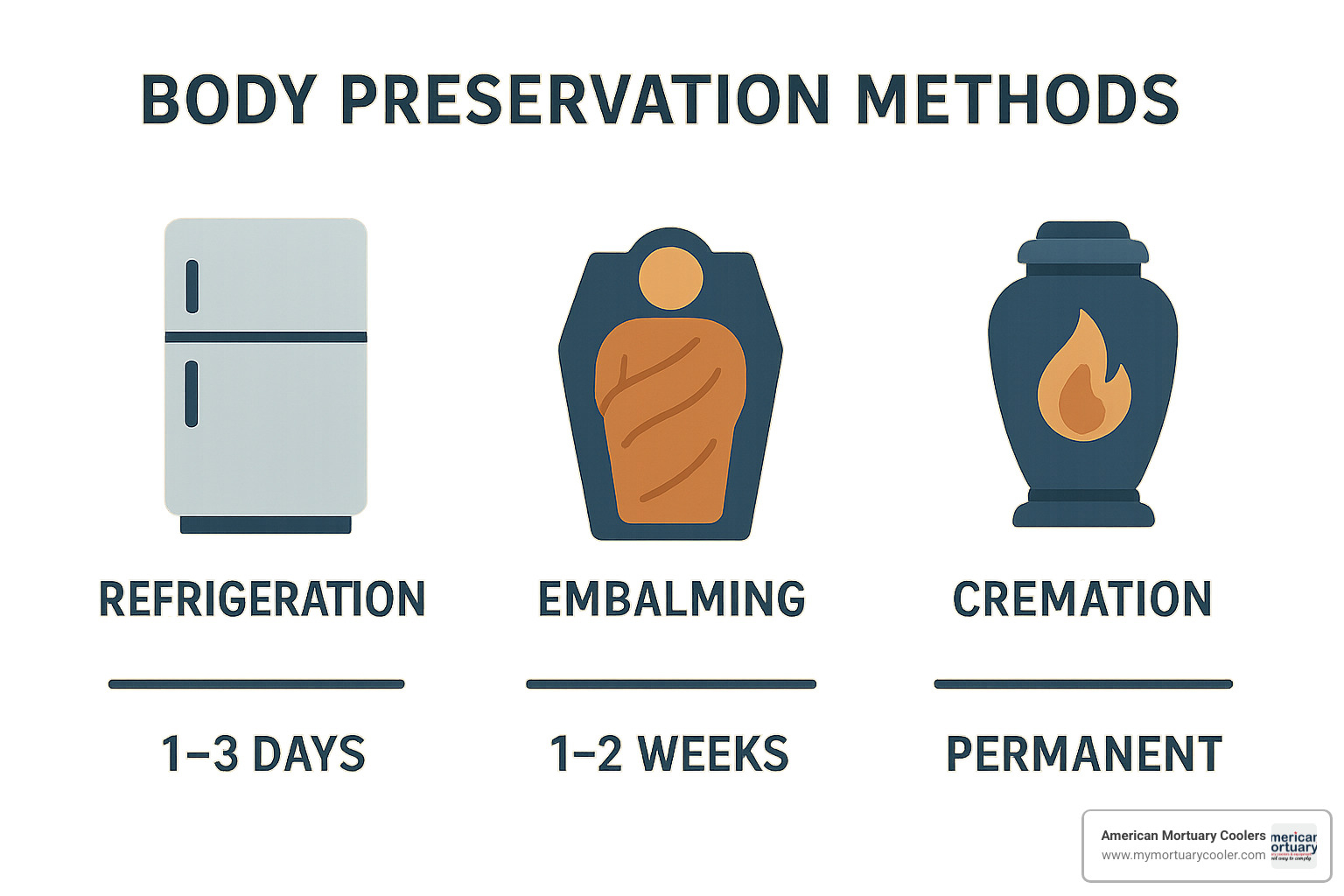
Refrigeration: The Standard Approach
Refrigeration at that sweet spot of 35°F-40°F has become the go-to method for most funeral homes today. It's beautifully simple - cooling the body slows down nature's processes without introducing chemicals.
Most families appreciate that refrigeration preserves their loved one for 3-4 weeks under good conditions, which gives everyone time to travel and make arrangements without rushing. It's also generally more budget-friendly than other options, making it accessible for most families.
"Many people don't realize refrigeration is actually the most natural approach," shares one of our funeral director clients. "It simply mimics what humans have done for centuries in colder climates."
The main limitation is that refrigeration requires consistent power and monitoring. And while it works wonderfully for preservation, viewing quality gradually changes over time, even in perfect conditions.
Embalming: Chemical Preservation
Embalming takes a different approach by replacing blood with formaldehyde-based solutions that temporarily preserve tissues. This traditional method remains popular for certain situations, especially when extended viewing periods are important to the family.
While embalming typically preserves a body for about one week for viewing purposes, it doesn't stop decomposition forever - it simply buys time. As one experienced funeral director told me, "We're honest with families that embalming provides a window of time, not permanence."
The process does involve additional costs and is more invasive than refrigeration. Some religious traditions prohibit embalming entirely, and it's often not permitted in green burial grounds. That said, for interstate transport, embalming is still required in many cases.
Dry Ice: Alternative Cooling
There's something wonderfully old-school about dry ice preservation. This solid form of carbon dioxide sits at a bone-chilling -78.5°C and provides cooling without any mechanical refrigeration.
Dry ice has become particularly popular for home funerals, where families care for their loved ones in familiar surroundings. It requires no electricity and aligns beautifully with green burial philosophies. The main drawback? You'll need to replace it roughly every 24 hours, and handling requires some safety precautions to prevent freezer burns.
One family we worked with used dry ice to supplement refrigeration during a three-day home vigil before returning their loved one to professional care. "It gave us precious time together in our own space," they shared.
Negative-Temperature Freezing
For special circumstances, deep freezing at temperatures between -50°C to -10°C can preserve bodies for several months. This method is most commonly used in criminal investigations or when long-term preservation is essential.
While freezing effectively halts decomposition more completely than refrigeration, it requires specialized equipment that most standard funeral homes don't maintain. The process can also cause tissue damage that might affect later viewing options. We generally don't recommend freezing unless there's a specific need for extended preservation.
Comparison Table: Preservation Methods
| Method | Typical Duration | Cost Range | Best For | Environmental Impact |
|---|---|---|---|---|
| Refrigeration | 3-4 weeks | $ | Most situations | Low (energy use) |
| Embalming | 1 week (viewing) | $$-$$$ | Open-casket viewing | Medium-High (chemicals) |
| Dry Ice | 24-48 hours per application | $-$$ | Home funerals, temporary needs | Low-Medium (production energy) |
| Freezing | Several months | $$$$ | Special circumstances | High (energy intensive) |
| No Preservation | <24 hours | Free | Immediate burial/cremation | None |
At American Mortuary Coolers, we've learned that regional needs vary dramatically. Funeral homes in Florida face different challenges than those in Montana. That's why our systems for the Southeast include redundant cooling capabilities and backup power connections to handle hurricane season, while our Rocky Mountain units feature specialized humidity control systems for those dry conditions.
"Refrigeration is increasingly recognized as the most environmentally friendly option," notes Everplans, reflecting a growing trend we're seeing across the country as more families prioritize sustainable choices.
For many families, the answer to how long can a body be refrigerated before burial ultimately depends on their specific circumstances, cultural practices, and what feels most aligned with their loved one's wishes. Whatever choice they make, proper equipment ensures dignity is maintained throughout.
More info about mortuary freezers
Frequently Asked Questions About Body Refrigeration Duration
How long can a body be refrigerated before burial if we skip embalming?
When families ask how long can a body be refrigerated before burial without embalming, I'm always careful to explain the nuances. In most cases, refrigeration provides a comfortable 3-4 week window for making arrangements, which is usually plenty of time for:
Families often need this time when loved ones are traveling from across the country, or when they're waiting on cemetery availability. I remember helping one family who needed extra time while relatives made their way from Alaska – refrigeration gave them the peace of mind to wait until everyone arrived.
For families choosing home vigils (which are becoming more popular), refrigeration alternatives like dry ice can work wonderfully for shorter periods. As Lee Webster, who advocates for home funerals, often says: "Cooling the body within the first four to six hours following death helps to achieve a much better outcome." I couldn't agree more – those first few hours make all the difference.
The appearance of your loved one does change over time, even with refrigeration. Most of us in the funeral profession gently recommend having viewings within the first week for the best presentation when skipping embalming. After this point, many families find a closed-casket service more appropriate.
Does refrigeration replace embalming for open-casket funerals?
This is one of the most common questions we hear when discussing how long can a body be refrigerated before burial. The answer really depends on your timing and expectations.
For quick viewings within the first few days after death, refrigeration alone often works beautifully, especially when:
- Your loved one passed peacefully
- You're planning a brief viewing
- The room will stay cool and controlled
I've seen many meaningful viewings where families chose refrigeration only, and they were perfect for their needs. However, for traditional open-casket funerals with longer viewing periods, refrigeration alone typically doesn't provide the same results as embalming.
As one funeral director with decades of experience put it to me, "Embalming allows for better cosmetic preparation and preservation during extended viewings. Refrigeration preserves but doesn't restore." That's a perfect way to explain the difference.
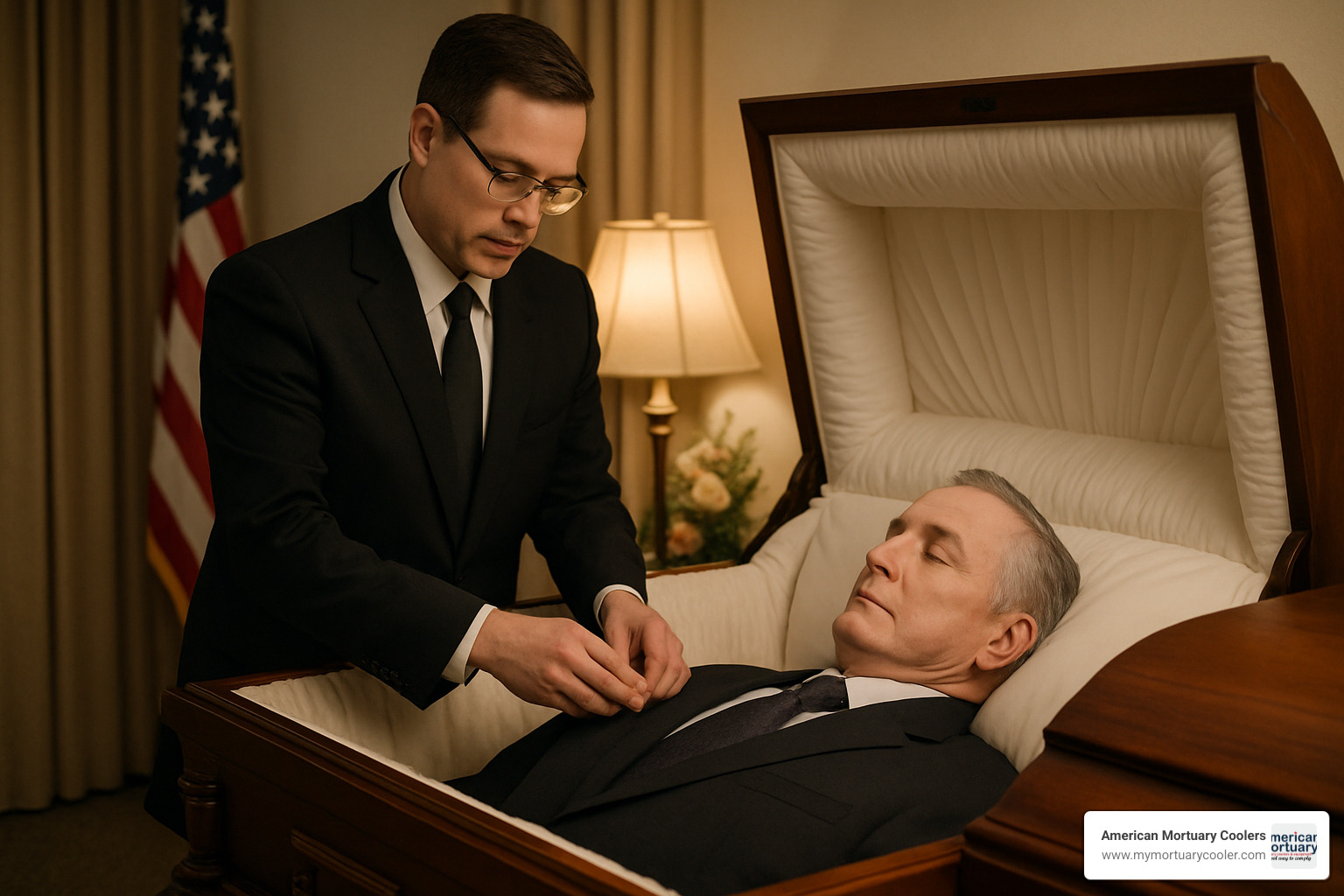
Many funeral homes now offer blended approaches to honor both tradition and personal preferences. They might refrigerate until shortly before viewing, use minimal preservation techniques for the service, then return to refrigeration afterward. Religious considerations are important too – some traditions strictly prohibit embalming but welcome refrigeration as an alternative.
What does refrigeration cost at most funeral homes?
Talking about costs during grief is never easy, but understanding refrigeration fees helps families make informed decisions about how long can a body be refrigerated before burial.
Most funeral homes include some refrigeration time (usually 3-7 days) in their basic service fee. It's considered an essential function, like transportation or filing death certificates. Beyond this included period, costs typically shift to:
Daily rates around $35-$75, weekly rates between $150-$350, or sometimes monthly options for special circumstances. These fees reflect real costs – the electricity to power coolers, maintenance of equipment, and the facility space itself.
I've noticed prices tend to run higher in major cities like New York or Los Angeles, areas with higher energy costs, or regions with fewer funeral home options. As one funeral director explained to me, "We try to be fair with refrigeration fees because we know families sometimes need extra time to gather or make decisions."

At American Mortuary Coolers, we've seen how funeral homes with modern, energy-efficient refrigeration systems often offer more competitive rates to families. Our newer units for the Midwest and Northeast regions can reduce electricity use by up to 30% compared to older systems, savings that thoughtful funeral directors often pass along to the families they serve.
When comparing options, don't hesitate to ask specifically about how many days of refrigeration are included in the basic fee, when additional charges begin, and whether there are maximum storage periods. Clear communication about these details helps prevent surprises during an already difficult time.
Conclusion
Understanding how long can a body be refrigerated before burial touches on science, legal requirements, and the emotional needs of families. While that 3-4 week guideline gives us a practical framework, every situation has its own unique factors that might extend or shorten this timeframe.
Here's what we've learned through our journey together:
Temperature control makes all the difference. Keeping conditions steady at 35°F-40°F is like the golden rule of body preservation. It's the one factor that can truly extend how long respectful refrigeration remains viable.
Most state regulations focus on when preservation should begin—typically within 24-48 hours after death—rather than placing limits on how long refrigeration can continue. This gives families some flexibility during difficult times.
Timing matters tremendously. Bodies that are refrigerated promptly after death generally preserve better and longer than those where cooling was delayed. Those first few hours make a significant difference in the weeks that follow.
Even with perfect conditions, refrigeration has natural limits. Physical changes eventually make extended refrigeration impractical, which is why that 3-4 week mark tends to be the practical ceiling for most situations.
Families do have choices based on their needs, values, and circumstances—from traditional embalming to dry ice solutions or even specialized freezing options for unique situations.
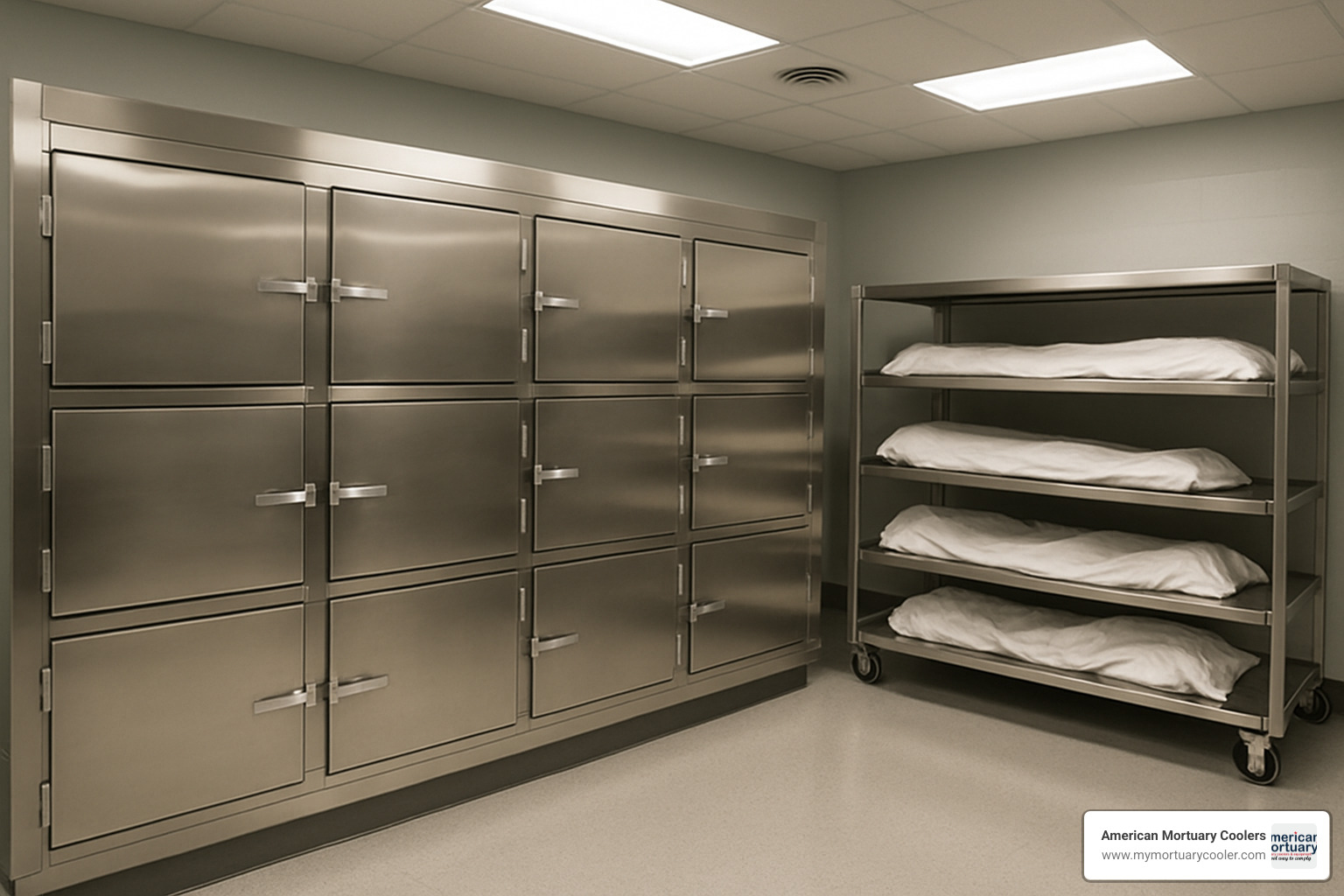
At American Mortuary Coolers, we've spent decades helping funeral homes across the country provide dignified, reliable refrigeration solutions. From our home base in Johnson City, Tennessee, to funeral homes from New York to Los Angeles, we've built custom mortuary coolers designed to maintain those perfect preservation conditions while fitting each facility's unique space requirements.
We never forget that behind every technical question about refrigeration is a family making difficult decisions during their most vulnerable moments. Our equipment plays a vital but quiet role in giving those families the precious time they need to gather, grieve, and honor their loved ones in ways meaningful to them.
For funeral homes looking to upgrade their refrigeration capabilities or new facilities planning their initial setup, we provide durable, energy-efficient solutions with direct delivery throughout the contiguous 48 states. Our regional specialists understand the unique challenges of mortuary refrigeration in diverse climates—from the humid Southeast to the arid Southwest, we've designed systems that work reliably where you live.
The question of how long can a body be refrigerated before burial will always involve case-by-case considerations, but with proper equipment and thoughtful protocols, funeral professionals can provide families with the time and options they need during life's most challenging transition.
















